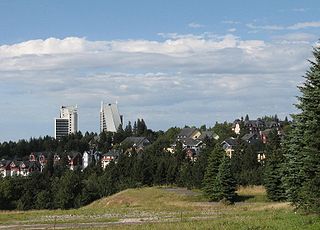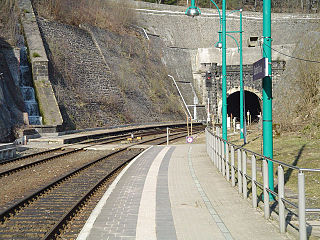History
The first official run took place on 12 May 1973 as the I. 100-km GutsMuths Rennsteiglauf. It was intended to commemorate the pedagogue Johann Christoph Friedrich GutsMuths. The course of almost 100 kilometers led from the Hohen Sonne near Eisenach to Masserberg. The four participants Hans-Georg Kremer, Hans-Joachim Römhild, Jens Wötzel and Wolf-Dieter Wolfram ran without any competitive intention and reached the finish together after 9:55 hours. The following year, the event was repeated on May 17 on a route of 82 kilometers - from Heuberghaus to Neuhaus. Eight of twelve participants reached the finish line after 10:35 hours: G. Clausnitzer, K. Gottert, R. Knoch, H.-G. Kremer, H.-J. Römhild, W. Schuck, J. Wötzel, and S. Ziegan.
On 9 May 1975 the Rennsteiglauf was held as a competition for the first time. In addition to the 50-mile run (82 km), a second course of 38 km was set up for women, starting at the youth hostel at Rennsteig station near Schmiedefeld am Rennsteig. Of a total of 974 participants, 811 reached the finish (long course: 692 men, 10 women; short course: 108 women, 1 man). In 1976, the course length was reduced to 75 km, and later to 68 km (1983-1985) and 65 km (1986-1996).
The run was organized on a voluntary basis and initially remained without support from the DTSB board. In the end, the run had cult status. Amateur athletes from all over the GDR made a pilgrimage to the Rennsteiglauf.
Since 1997, the run has had its current length with the start in Eisenach. Since 2017, after a remeasurement, the course length is given as 73.5 km instead of the previous 72.7 km. The shorter run has been started in Neuhaus since 1977, initially over 45 km, 43.5 km and from 2016 over the marathon distance.
Since 1992, the half marathon from Oberhof to Schmiedefeld has been held, and since 1993, children's races have been part of the program. Over time, the Rennsteiglauf developed into the largest popular sports event in the GDR. Today, it is one of the largest popular runs in Germany and has been regularly ranked among the ten most popular runs in Germany by Laufzeit magazine since 1991. Trademarks are the stomach-friendly gruel at the aid stations, the dedicated helpers along the course who are recruited from local sports clubs, and the "dumpling parties" on the eve in the starting towns as well as the runners' parties in the finishing town of Schmiedefeld am Rennsteig.

The Thuringian Forest, is a mountain range in the southern parts of the German state of Thuringia, running northwest to southeast. Skirting from its southerly source in foothills to a gorge on its north-west side is the Werra valley. On the other side of the Forest is an upper outcrop of the North German Plain, the Thuringian Basin, which includes the city Erfurt. The south and south-east continuation of the range is the highland often called the Thuringian-Vogtlandian Slate Mountains.

An ultramarathon, also called ultra distance or ultra running, is any footrace longer than the traditional marathon length of 42.195 kilometres. Various distances are raced competitively, from the shortest common ultramarathon of 31 miles (50 km) to over 200 miles (320 km). 50k and 100k are both World Athletics record distances, but some 100 miles (160 km) races are among the oldest and most prestigious events, especially in North America.

The Two Oceans Marathon is a 56 kilometres (35 mi) ultramarathon and 21 kilometres (13 mi) half-marathon held annually in Cape Town, South Africa on the Saturday of the Easter weekend.

Trail running is a type of running that takes place on outdoor trails, often in mountainous terrain, and often includes significant ascents and descents. Trail running is overseen by the International Trail Running Association (ITRA) and includes longer races.

The Badwater Ultramarathon describes itself as "the world's toughest foot race". It is a 135-mile (217 km) course starting at 282 feet (86 m) below sea level in the Badwater Basin, in California's Death Valley, and ending at an elevation of 8,360 feet (2,550 m) at Whitney Portal, the trailhead to Mount Whitney. It takes place annually in mid-July, when the weather conditions are most extreme and temperatures can reach 130 °F (54 °C). Consequently, very few people, even among ultramarathoners, are capable of finishing the race.

Oberhof is a town in the Schmalkalden-Meiningen district of Thuringia, Germany. Located in the Thuringian Forest mountain range, it is a winter sports center and health resort. With 1,625 inhabitants, it is visited by 144,000 tourists every year (2016). The town obtained its official city status in 1985.
Multiday races are ultramarathon running events which are typically either segmented into daily events of a specified distance or time, or staged so that runners can run as far as they want, at their own discretion, over a set course or over a set number of days. Multiday races can range from continuous 48-hour track events to staged transcontinental treks.

The Barkley Marathons is an ultramarathon trail race held each year in Frozen Head State Park in Morgan County, Tennessee.

The Canberra Times Marathon Festival is an annual marathon held in the city of Canberra, Australian Capital Territory. The marathon was established in 1976 and is the oldest city marathon in Australia. The marathon was initially held on November before being moved to April in 1979.
The Antarctica Marathon® may have been the first for-profit sporting event held in Antarctica, on January 28, 1995. The event is now held every year in late February or early March. The 42.195-kilometre race is held on King George Island, one of the largest Antarctic Islands just off the Antarctic Peninsula. There is also a half-marathon held at the same time. The start and finish is at Bellingshausen Station, and the course passes the Artigas Base (Uruguayan), the Frei Base (Chilean) and the Great Wall Base (Chinese). The course follows a gravel road that connects the bases and changes each year based on the base operations as well as road and weather conditions.
The European Ultramarathon Cup, was an annual cup event covering some of the biggest Ultramarathon races in Europe from 1992 until 2019.

Lichte is a village and a former municipality in the district of Sonneberg in Thuringia, Germany, close to the Thuringian Rennsteig. Formerly in the district Saalfeld-Rudolstadt, it is part of the town Neuhaus am Rennweg since January 2019.

Everest Marathon is an annual marathon event, held in the district of Solukhumbu, Nepal, around the vicinity of Mount Everest in May. With its starting point at 5401m Meter from where the Climbing of Mount Everest Peak starts through the Ice Fall, the marathon is considered to be one of the highest and toughest races in the world. The marathon starts at the Mt. Everest Base Camp, and moves through the traditionally used high Sherpa trails of Khumbu Valley.

The Rennsteig is a ridge walk as well as an historical boundary path in the Thuringian Forest, Thuringian Highland and Franconian Forest in Central Germany. The long-distance trail runs for about 170 km from Eisenach and the Werra valley in the northwest to Blankenstein and the Selbitz river in the southeast.
The Harz Mountain Run is a mountain run, that has taken place since 1978 in October in Wernigerode in central Germany. Since 1990, its programme of events has included a marathon race, the Brocken Marathon, which is reckoned to be one of the toughest in Germany. Other events include a 22 km run and an 11 km run. In 2007 a 5 km run was offered for the first time that started at the same time as the 11 km run. The event attracts several thousand participants, e.g. in 2001 there were 3,500 and, in 2004, 3,110 runners finished, including 695 men and 73 women in the marathon. The record was achieved in 1987 with over 5,000 participants.

The Lichte (Thuringia) station German: Bahnhof Lichte (Thüringen) was a Deutsche Reichsbahn station in the Thuringian municipality of Lichte in the district of Saalfeld-Rudolstadt. The station is elevated 623 m above Sea Level.

The Equinox Marathon is an annual marathon held in Fairbanks, Alaska near the time of the autumnal equinox. It is one of the most difficult marathon courses in the world and includes 3285 ft. of elevation gain.

Brandleite Tunnel is a single-bore, double-tracked railway tunnel between the stations of Gehlberg and Oberhof in Thuringia. It leads the Neudietendorf–Ritschenhausen railway beneath the Brandleite massif, a part of the ridge of the Thuringian Forest that reaches a height of 897 m a.s.l. in this area. The tunnel is mostly straight, only at the Oberhof end the tracks curve slightly towards the south. With a length of 3,039 m (9,970 ft) it is the longest railway tunnel in Thuringia, and was the longest in the network of Deutsche Reichsbahn in the GDR. The maximum rock cover amounts to 237 m (778 ft).

The Plaue–Themar railway is a 62 kilometre-long, single-track, non-electrified, standard-gauge branch-line in the Thuringian Forest in Germany. The Stützerbach–Schleusingerneundorf section was built as the first Prussian rack railway between 1879 and 1904 and connects the Erfurt–Schweinfurt railway in the north via the towns of Plaue, Ilmenau, Schleusingen and Themar with the Eisenach–Lichtenfels railway in the south.

The Wachau Marathon is a 26.2-mile foot race on paved roads along the Danube River from Emmersdorf to Krems an der Donau in Wachau, Austria, usually held in September. The race was founded in 1998, and its course is certified by World Athletics. It has hosted the Austrian National Championships thrice before.


















